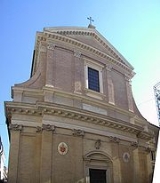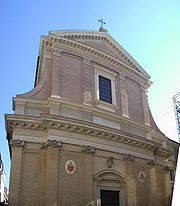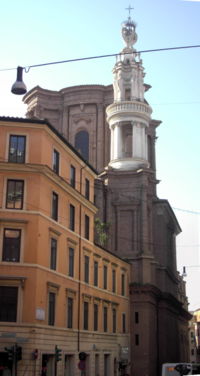
Sant'Andrea delle Fratte
Encyclopedia

Basilica
The Latin word basilica , was originally used to describe a Roman public building, usually located in the forum of a Roman town. Public basilicas began to appear in Hellenistic cities in the 2nd century BC.The term was also applied to buildings used for religious purposes...
church in
Churches of Rome
There are more than 900 churches in Rome. Most, but not all, of these are Roman Catholic, with some notable Roman Catholic Marian churches.The first churches of Rome originated in places where Christians met. They were divided into three categories:...
Rome
Rome
Rome is the capital of Italy and the country's largest and most populated city and comune, with over 2.7 million residents in . The city is located in the central-western portion of the Italian Peninsula, on the Tiber River within the Lazio region of Italy.Rome's history spans two and a half...
, Italy, dedicated to St. Andrew. The Cardinal Priest of the Titulus S. Andreae Apostoli de Hortis is Ennio Antonelli.
The current church was built over a pre-existing one, erected in 1192, called infra hortes ("between orchards", whence the name fratte, "woods") for it was located in a countryside area. It was the national church of the Scottish people
Scottish people
The Scottish people , or Scots, are a nation and ethnic group native to Scotland. Historically they emerged from an amalgamation of the Picts and Gaels, incorporating neighbouring Britons to the south as well as invading Germanic peoples such as the Anglo-Saxons and the Norse.In modern use,...
in Rome, until 1585, when Pope Sixtus V
Pope Sixtus V
Pope Sixtus V , born Felice Peretti di Montalto, was Pope from 1585 to 1590.-Early life:The chronicler Andrija Zmajević states that Felice's family originated from modern-day Montenegro...
donated it to the Friars Minor of Saint Francis of Paola.
In 1604 the construction of the new church was begun, to the design of Gaspare Guerra. The project, halted eight years later, was revamped in 1653 by Francesco Borromini
Francesco Borromini
Francesco Borromini, byname of Francesco Castelli was an architect from Ticino who, with his contemporaries, Gian Lorenzo Bernini and Pietro da Cortona, was a leading figure in the emergence of Roman Baroque architecture.A keen student of the architecture of Michelangelo and the ruins of...
, who is responsible of the apse, the tambour
Tambour
In classical architecture, a tambour is the inverted bell of the Corinthian capital around which are carved acanthus leaves for decoration....
of the cupola and the square campanile
Campanile
Campanile is an Italian word meaning "bell tower" . The term applies to bell towers which are either part of a larger building or free-standing, although in American English, the latter meaning has become prevalent.The most famous campanile is probably the Leaning Tower of Pisa...
with four orders. After his death, the construction was continued by Mattia De Rossi
Mattia de Rossi
Mattia de Rossi was an Italian architect of the Baroque period, active mainly in Rome and surrounding towns.Born in Rome to a family of architects and artisans, he rose to prominence under the mentorship of Gian Lorenzo Bernini, and even inherited the position as chief architect of the Fabbrica di...
. The late Renaissance-style façade, with two orders divided by pilaster
Pilaster
A pilaster is a slightly-projecting column built into or applied to the face of a wall. Most commonly flattened or rectangular in form, pilasters can also take a half-round form or the shape of any type of column, including tortile....
s, was completed in 1826.

Jacques Courtois
Jacques Courtois was a French painter.-Biography:He was born at Saint-Hippolyte, near Besançon. His father was a painter, and with him Jacques remained studying up to the age of fifteen...
and on the wall is a “Baptism of Christ” of Ludovico Gimignani
Ludovico Gimignani
Ludovico Gimignani was an Italian painter, active mainly in Rome, during the Baroque period.Ludovico's father, Giacinto had been one of the main pupils emerging from the loose "studio" of painters working for Pietro da Cortona and who also received patronage from his fellow Pistoia native, the...
. In the third chapel is the funeral monument of Cardinal Pierluigi Carafa
Pierluigi Carafa
Pierluigi Carafa, Junior was an Italian cardinal from the famous Neapolitan family of Italian nobles, clergy, and men of arts. He served the papacy as Camerlengo of the Sacred College of Cardinals and as Dean of same College...
sculpted by Pietro Bracci
Pietro Bracci
Pietro Bracci was an Italian sculptor working in the Late Baroque manner.-Biography:He was born in Rome and became a student of Giuseppe Bartolomeo Chiari and Camillo Rusconi...
. In the cloister, the lunettes are frescoed with stories from the life of Saint Francesco by Marini, Francesco Cozza
Francesco Cozza
Francesco Cozza may refer to:* Francesco Cozza * Francesco Cozza...
, and Filippo Gherardi
Filippo Gherardi
Filippo Gherardi was an Italian painter of the Baroque period.Born in Lucca, he was mostly active in Venice and Rome, where he became a member of the large studio of Pietro da Cortona, often working closely with Giovanni Coli. With Coli, Gherardi was initially a trainee of Pietro Paolini in Lucca...
. In the transept, the altar (1736) was designed by Filippo Barigioni
Filippo Barigioni
Filippo Barigioni was an Italian sculptor and architect working in the Late Baroque tradition.Bariogioni was born in Rome. His career was spent largely on papal commissions, including aqueducts and fountains, in and around Rome...
, the altarpiece of Saint Francis of Paola was painted by Paris Nogari
Paris Nogari
Paris Nogari was an Italian painter of the Renaissance period, a minor pupil of Cesare Nebbia active mainly in Rome. He painted in the library of the Vatican in a style resembling Raffaellino da Reggio and was among the painters who frescoed Santa Susanna.-References:...
, the stuccoed angels were added by Giovanni Battista Maini
Giovanni Battista Maini
Giovanni Battista Maini was an Italian sculptor of the Late-Baroque period, active mainly in Rome.He was born in Cassano Magnago in Lombardy, and died in Rome. He may have had contacts with Foggini in Florence. By 1708, he had moved to Rome where he joined the large studio of Camillo Rusconi,...
. The presbytery dome has a fresco of the Multiplication of the loaves and fishes by Marini. Behind the altar, is a Crucifixion of Sant’Andrea by Giovanni Battista Lenardi, the Entombment of Sant’Andrea by Francesco Trevisani
Francesco Trevisani
thumb|250px|Portrait of [[Pietro Ottoboni |Cardinal Pietro Ottoboni]] by Francesco Trevisani. The [[Bowes Museum]], [[Barnard Castle]], [[County Durham]], [[England]]....
, and a Death of Saint Andrew by Lazzaro Baldi
Lazzaro Baldi
Lazzaro Baldi was an Italian painter of the Baroque period, active mainly in Rome.-Biography:Baldi was born in Pistoia and died in Rome. He was part of the large studio of Pietro da Cortona, and became adept at fresco technique. He painted a David and Goliath for Alexander VII in the Palazzo...
. At the sides of the presbytery are Angels (1668-1699) designed by Bernini for the Ponte Sant'Angelo
Ponte Sant'Angelo
Ponte Sant'Angelo, once the Aelian Bridge or Pons Aelius, meaning the Bridge of Hadrian, is a Roman bridge in Rome, Italy, completed in 134 AD by Roman Emperor Hadrian, to span the Tiber, from the city center to his newly constructed mausoleum, now the towering Castel Sant'Angelo...
, but later moved here and replaced on the bridge with copies (of the two, only the "Angel with the Crown of Thorns
Angel with the Crown of Thorns
"Angel with the Crown of Thorns" is a statue by G.L. Bernini commissioned by Pope Clement IX, now in the church of Sant'Andrea delle Fratte in Rome, Italy. The statue was started in 1667 and completed in 1669....
"). The altar in the left transept was designed by Luigi Vanvitelli
Luigi Vanvitelli
Luigi Vanvitelli was an Italian engineer and architect. The most prominent 18th-century architect of Italy, he practiced a sober classicizing academic Late Baroque style that made an easy transition to Neoclassicism.-Biography:Vanvitelli was born at Naples, the son of a Dutch painter of land and...
and Giuseppe Valadier
Giuseppe Valadier
Giuseppe Valadier was an Italian architect and designer, urban planner and archeologist, a chief exponent of Neoclassicism in Italy.-Biography:...
with an altarpiece of Saints Anne, Young John the Baptist, and Mary by Giuseppe Bottani
Giuseppe Bottani
Giuseppe Bottani was an Italian painter active in the Baroque period.He was born in Cremona. In Florence, he was a pupil of Vincenzo Meucci and il Puglieschi. He moved to Rome to work under Agostino Masucci, then he returned to Cremona after 1745. In 1769, he was named professor of painting and...
. In the third chapel on the left is a Madonna of the Miracle of Domenico Bartolini, to commemorate the place where supposedly, on 20 January 1842, Mary, mother of Christ, appeared to a Jewish young man, Maria Alphonse Ratisbonne, causing him to convert to Catholicism. In honor of this visitation, the pews of the church are oriented to this altar.

